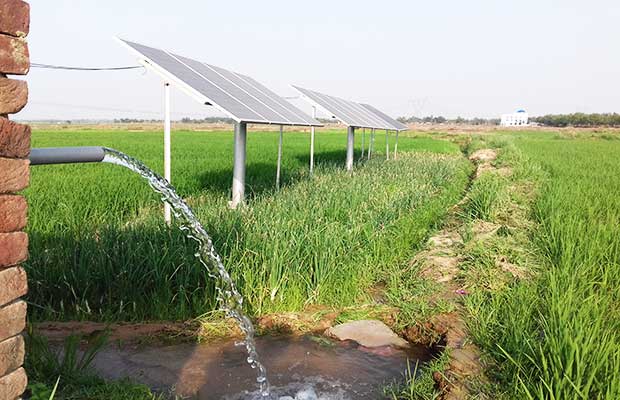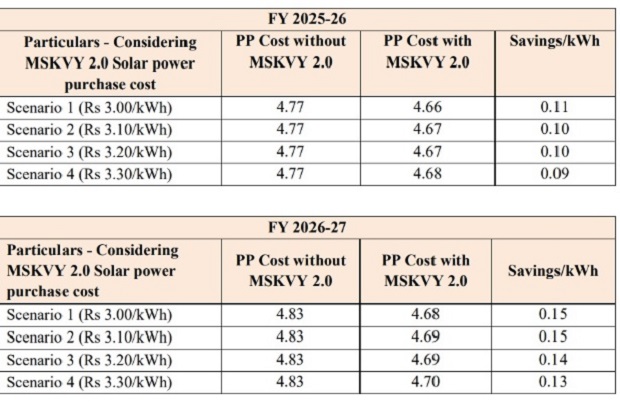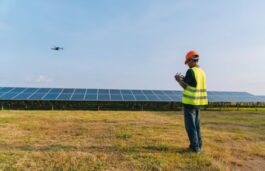Highlights :
- Several states like Maharashtra are now pushing hard for increased solarisation of their agricultural feeders to allow consistent power to its farmers during day-time.
- Some states like Bihar which don’t have any operational off-grid solar pump scheme have also planned to jump onto the bandwagon.
- In our latest cover story, we analysed the ground realities and the challenges towards this mission.
 KSB Ltd Pockets Order for 800 Solar Water Pumping Systems from UP Govt
KSB Ltd Pockets Order for 800 Solar Water Pumping Systems from UP Govt Radheshyam Singh is a marginal farmer from Noorsarai in the Nalanda district of Bihar. While a few farmers from the district have availed the benefits of off-grid solar pumps for irrigation in the past, Radheshyam and most of the farmers in the neighbourhood still depend on the grid. However, dependency on the grid for irrigation comes with its own challenges.
Singh says it is erratic and the discoms provide power several times during the nighttime. This makes it challenging for the farmers to venture into their fields to irrigate their land. “Several rural areas in Bihar get erratic power supply. Sometimes, it is given during the daytime for farmers and sometimes during the night. Venturing into the fields for irrigation during the night often poses the threat of snake bites and other threats, while during winter for the rabi crop, the problem cascades,” Singh said.
Despite being the poorest state of the union, Bihar remains one of the few Indian states that currently do not have any active solar off-grid pump schemes for its farmers. PM-KUSUM is yet to roll out in the state. Bihar Renewable Energy Development Agency (BREDA) Director Mahendra Kumar recently announced that the state, scarred by the maintenance issues of the off-grid solar pump scheme, would focus on solarisation of its agriculture feeders with the large corpus it received under the Revamped Distribution Sector Scheme (RDSS). The Union government launched RDSS for a period of 2021-22 to 2025-26 with an aim to reduce the Aggregate Technical & Commercial (AT&C) losses to 12%-15%.
The plan is to have smaller decentralized solar plants of 1 MW under the RESCO model and use the same to solarise the agriculture feeders. It is likely to reduce the CAPEX, making it more fruitful for the discoms as the developer invests. It could also ensure maximum utilization of the surplus solar power.
Will Maharashtra Set The Pace, Again?
Bihar might yet learn a thing or two from Maharashtra, when it comes to renewable powered agri feeders. Maharashtra seems to be the pioneer in taking steps towards this direction. The Maharashtra State Electricity Distribution Co Ltd (MSEDCL), in its latest petition before the Maharashtra Electricity Regulatory Commission (MERC), told the Commission that it plans to procure 7 Gigawatt (GW) of solar power on a long term basis under its Mukhyamantri Saur Krushi Vahini Yojana (MSKVY) 2.0 with a special focus on solar feeders.
MSEDCL’s objective was to use this to achieve its Renewable Purchase Obligations (RPO), reduce the procurement cost of solar power and solarisation of agricultural feeders. It also said that this could help ensure power for farmers during the daytime. Under the scheme, the government plans to achieve 30 percent solarisation of its agriculture feeders by 2025. It allows solar plants from 0.5 MW to 25 MW in rural areas. ‘

MSEDL’s calculation submitted before MERC on cost-saving with the reference of Rs 3.10/kWh has adopted from the Commission’s order dated 24 May 2023. Source: MERC
MSEDCL said 32 percent of Maharashtra’s power consumption comes from the agriculture sector alone. The state utility admitted to giving power to farmers during the night time on a rotational basis. It also said that the new scheme could help in solving the problem. It also presented a cost breakup on how the infusion of cheaper solar power could reduce procurement costs and ensure that solar power dominates the agriculture feeders.
“At present, the average power demand for the agriculture sector across Maharashtra is around 14,000 MW. This demand is supplied such that 50 percent of the agricultural feeders, on a rotational basis, are provided energy during the daytime with the remainder of the feeders being provided energy in the night time,” the MSEDCL said in its petition.
Maharashtra now plans to produce 50 percent of this agriculture demand through solar power to ensure all farmers receive power during the daytime. The state farmers can also avail the Central Financial Assistance (CFA) under the Component-C of the PM-KUSUM under the MSKVY 2.0.
Even the Ministry of New and Renewable Energy (MNRE) lauded the features of MSKVY 2.0 and amended the PM-KUSUM norms to include such features. “…It is observed that the land aggregation model being implemented by Maharashtra is forward-thinking and meticulously planned. The intention is to take land and lease with commensurate lease rent for farmers, to make sure the availability of land for solar projects…” an MNRE order dated July 12, 2023 said.
Other states not behind
Similar schemes have been tried in other states, too. For example, in 2022, Rajasthan started the Saur Krishi Aajevika Yojana (SKAY) programme to install solar plants in farmers’ barren lands where they can lease their barren land for solar projects. Solar developers can use such lands for installing solar plants. The Jodhpur Vidyut Vikas Nigam Limited (JdVVNL) in 2022 also issued tenders for solarising 17 agricultural feeders in their jurisdiction. Gujarat has followed a similar path.

Anas Rehman, Policy Adviser, IISD
Experts hail the decision to go for solar feeders but claim it should not be seen as an alternative to off-grid solutions. “Solarisation of feeders is meant for farmers using the grid for pumps. Off-grid pumps are meant to serve the farmers not covered by the grid and use diesel and other sources to ensure dependable power when they need it. The idea is good, but it could work out well for states like Maharashtra, Gujarat, Madhya Pradesh and others that have good feeder segregation successes. In states like Bihar, where a large number of farmers use diesel to fuel their pumps. Solar feeders, thus, should not be seen as an alternative to off-grid solutions,” Anas Rehman, Policy Adviser at the International Institute for Sustainable Development (IISD), told Saur Energy.
Rehman said that solarisation of feeders would help the discoms to reduce costs, thanks to the many exemptions on other charges for solar energy. “With this the discoms can cut down on the transmission costs. It can also help them to avoid several transmission-related charges too,” he added.
According to the World Resources Institute (WRI)-India, 42 percent of the power sales by discoms in Rajasthan go to the agricultural sector, expected to touch 45 percent in time. According to a report from The Energy & Resources Institute (TERI), the agricultural power demand is slated to rise nationally to 238-307 TWh by 2030 from 198 TWh in 2021.
Energy-related think tanks in their reports have also highlighted the role of increased solarisation of agricultural feeders. A report by Pune-based Prayas Energy Group claimed that solar feeders are more farmer-centric for the farmers as they ensure equity. It also talked about less investment burden on the government and the possibility of more export of solar power, which is otherwise not possible in off-grid solar pumps when they are not used for pumping.
Challenges
 The solarisation of feeders has often faced hurdles in different states and is also evident from the poor response in Component C of the PM-KUSUM scheme. Chhattisgarh is one of the few Indian states with a higher solar pump penetration with the state’s own scheme. As per the latest data from the Chhattisgarh Renewable Energy Development Agency (CREDA), it has installed more than 1.5 lakh solar pumps under its state scheme.
The solarisation of feeders has often faced hurdles in different states and is also evident from the poor response in Component C of the PM-KUSUM scheme. Chhattisgarh is one of the few Indian states with a higher solar pump penetration with the state’s own scheme. As per the latest data from the Chhattisgarh Renewable Energy Development Agency (CREDA), it has installed more than 1.5 lakh solar pumps under its state scheme.
However, it claimed that its tenders for the solar feeders did not yield a good response from the solar developers. “In such cases, plans are to install smaller decentralized solar plants. The tariffs for such smaller projects often range around Rs 3.15 per unit or nearby, which seems to deter developers. CREDA, too, had invited bids for such projects and did not get a good response through such tenders. It is the case not only in Chhattisgarh for several other states which tried to have smaller solar plants and promote feeder level solarisation,” Sanjeev Jain, Advisor to CREDA, told Saur Energy.
“In states like Bihar, there is a dearth of barren land. Wherever there is farming land, they are costlier. In such a case, constructing 1 MW solar plants in rural areas would be challenging. And if the plan is to have several such units in rural areas, it will be tough to implement.

Amarnath Gupta, Sr Project Manager, Prostarm
Undoubtedly, the government and the discoms can reduce their costs with this plan. Moreover, in such cases, only those areas are preferred which are within 5 km of any substation. What about the far-flung areas? We would need off-grid solar pumps too,” Patna-based Amarnath Gupta, Senior Project Manager, Prostarm Info System, an EPC player, told Saur Energy.
Chandrashekhar Mishra, Chairman of the Solar Energy Society of India (SESI) of Odisha, told Saur Energy that grid-connected feeders would lead to a lack of choice for the farmers. He said it is in addition to the low tariff issues, which could prove a deterrent for the developers to go ahead with such tenders. He said that unless the tariff becomes more than Rs 4 per unit, the wider interest of developers would be tough.

Chandrashekhar Gupta, Chairman, SESI, Odisha
“In off-grid, the farmers control their assets and have assured power during daytime. If the government moves away from off-grids and moves to grid-connected options, farmers will lose such control. Moreover, in the 11 KV lines, there is much load shedding, which could affect the irrigation potential of the farmers. There are other practical issues, too. Metering and timely disbursement of payments to developers are other bottlenecks in such plans. So RESCO mode options may not work out well for the developers,” Mishra said.
Conclusion
The idea of renewable-powered agri feeders has always been attractive, considering how it avoids the biggest limitation of solar energy, the lack of round- the-clock supply, considered inessential in the sector. However, like the fertilizer subsidy that goes primarily to fertilizer PSUs and other corporates in the name of farmers, the power subsidies in many states have also distorted the market for viable renewable-powered agricultural feeders. The advent of the DBT (Direct Benefit Transfer) scheme for farmers, smart metering, and better remuneration for developers certainly holds the potential to provide a fillip to the growth of solar here.
And compared to power subsidies, it offers the potential for payback to the discoms in 5-7 years and free power thereafter if we consider the promised life of a well-made solar plant in the MW range at 25 years. It will take a concerted effort and will to make it happen across states, with no small help from the Centre in policy direction, funding support, perhaps including assurance of payments to developers, and broader power reforms that direct subsidies more sharply where needed. It’s not impossible, and soon enough, we will know if progress is finally possible here.



























